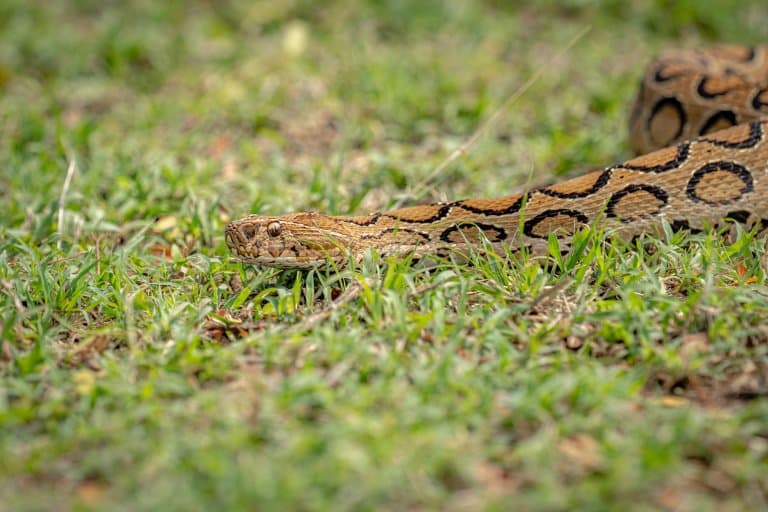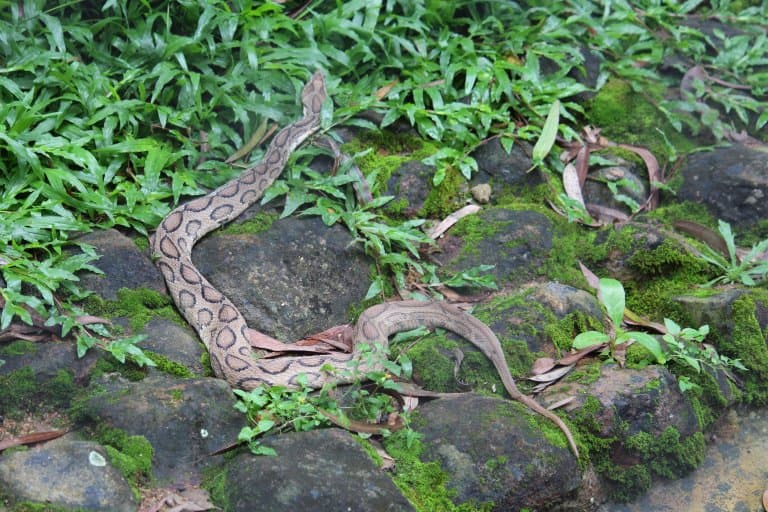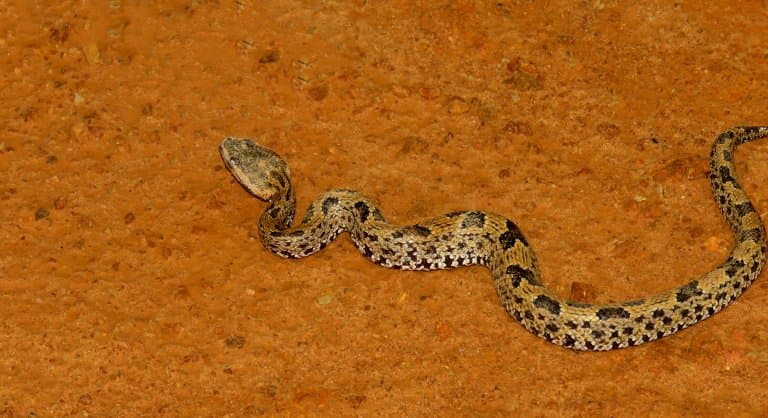Russell’s Viper Profile
There are four major contributors to snake bite deaths in India. Each with its own unique and terrifying qualities. The common krait, as innocuous as it sounds, sneaks into the beds of sleeping villagers, often paralysing them with a bite when they inevitably roll over onto it.
The Indian Cobra rears up and displays its impressive hood before injecting a huge quantity of venom. The saw-scaled viper sizzles a warning while oscillating its colours in a hypnotic show, and today’s subject, the Russell’s Viper just sits there, waiting…
Russell’s viper is a venomous snake from the viper family, that’s native to the Indian subcontinent.

Russell’s Viper Facts Overview
| Habitat: | Forest, shrubland, Grassy areas |
| Location: | South Asia, Pakistan to China, Indonesia |
| Lifespan: | 15 years |
| Size: | Over 1.5m (5ft) long |
| Weight: | 5lbs |
| Colour: | Earthy brown/grey with rusty red spots |
| Diet: | Nostly rodents, other small mammals |
| Predators: | Possibly cobras |
| Top Speed: | Unknown |
| No. of Species: | 1 |
| Conservation Status: | Least Concern |
Named after its ambush-style, the Russell’s viper is dangerous specifically because it hides, rather than fleeing.
It’s found across the Indian subcontinent in India, Sri Lanka, Bangladesh, Nepal, and Pakistan. In many regions such as Punjab and the west coast, it’s extremely common in open grasslands and farmland.
They primarily feed on rodents such as rats, which means they can be found in highly urbanized areas and settlements in the countryside searching for prey.
Its habitat overlaps significantly with rural Indian communities, and this makes long grass a dangerous substrate for farmers and amblers alike.
But is total annihilation a healthy response to a deadly snake? Their role in the ecosystem and, indirectly, the local economy, suggests there may be a better solution.
Interesting Russell’s Viper Facts
1. They are named, ‘the lurker’
The species name of the Russell’s Viper, russelii, is named in honour of Patrick Russell, a Scottish herpetologist who made significant contributions to the study of Indian serpents.
Taxonomically, it belongs to the family Viperidae and is closely related to other pit vipers, sharing a certain potency and social infamy with other members of the family.
The genus, Daboia, is derived from the Hindi word “Dabaiyya,” meaning “that lies hid,” or “the lurker,” referring to the snake’s cryptic nature. This is a snake that will sit and wait, perfectly camouflaged, in the grass until an unwitting rodent comes along.
Unfortunately, sometimes an unwitting human comes along instead, and the results are often similar.

2. They’re very dangerous
Snake venom typically evolved to rapidly put a stop to a small mammal’s ability to struggle, and therefore help protect the feeding snake from injury. Unfortunately, as mammals, this makes humans susceptible to the venom too, and so despite being from different worlds, snakes and humans became fearful of one another.
The Russell’s Viper is one of South Asia’s “Big Four” venomous snakes and is notorious for its lethal venom. Like other ‘most deadly snakes‘, it’s not just the potency but also the high chance of human contact that makes these snakes so deadly.
As such, they contribute significantly to overall snakebite deaths in India – causing an estimated 25,000 fatalities annually.
The venom is no joke; it causes acute kidney failure and blood clotting issues, and as such, research is desperately needed to determine the best dialysis treatment timing to minimize fatalities.
But while there are innumerable potential ways to reduce the danger, the current method is widespread culling.
And this is unfortunate because while the snake’s response to fear is generally to run away, the human response is to destroy everything that loosely resembles the source of the fear and kill everything around it too, just to be sure.
Ironically, this has always come around to bite people in the ass.
3. Their fangs grow over half an inch
Vipers have fangs, and the Russell’s Viper fangs reach a length of around 0.65 inch on average. This is enough to cause a painful bite, as well as administer their venom.
When threatened, they form a series of S-loops and can bite with a strong violent ‘snap’, or they can hang on for longer with their fangs.
They don’t always bite though, sometimes if they are stood on, they just want to get away!
4. They have a hidden heat radar
The Russell’s Viper does not have heat-sensitive pit organs like those common to pit vipers, but they are believed to have a heat-sensitive organ of some kind.
It’s unknown exactly what this is still, but the nerve endings in the supranasal sac are similar to those found in other heat-sensitive organs.
It helps them identify and hunt small mammals from their warm heat signature.
5. They help reduce disease spread
Snakes play a vital role in controlling the populations of various small mammals – in the case of the Russell’s viper, mainly rodents.
By regulating these numbers, they help maintain a balanced ecosystem and also aid in controlling the spread of diseases that rodents often carry, such as leptospirosis or hantavirus.
Further, since snakes don’t eat crops and rats do, replacing rat biomass with that of a more serpentine quality helps improve yields, too.

6. Reducing human contact is the key to coexistence
As much as we hate to admit it, small changes in our habits can have huge positive effects on the ecosystem.
In areas where these snakes are so prevalent, a handful of interventions can reduce lethal bites to almost zero.
First, getting torches to farmers will help them spot the snake before stepping on it, but cheap rubber boots will also go a long way to preventing bites from landing if they get too close.
Understanding the defensive nature of these bites is also important. Making cleared pathways provides people with routes to walk that don’t intersect with the ambush locations of the snake, and finally, providing local clinics and healers with the tools needed to address a bite can save lives very effectively.
Antivenom alone is remarkably successful against viper bites, so getting vials of it out to the right people is key.
Then, education about the importance of snakes in the function of the ecosystem and their economic value as pest control is crucial to reducing unnecessary interactions and culls.
And these snakes have clinical significance outside of their lethality. 1
7. Their venom may have other clinical uses
On top of the need to collect it for antivenom treatments, there are other potential applications for the compounds found in this snake’s venom.
This snake bite contains 63 individual proteins, from 12 protein families, making it a complex cocktail of poison. Understanding these is the key to making effective treatments for snake bites, but some of these proteins can have potential effects against other conditions.
At least one peptide has shown wound-healing properties, antimicrobial effects, and anti-inflammatory potential. 2 3

8. They’re stunning!
Regardless of how terrifying they might be, there’s no denying how striking a Russel’s viper looks.
Elongated, red-brown eyespots pepper the earthy tones of its body, breaking up the shape and allowing it to disappear into the grass entirely.
These skins were sought after by leather companies in the West, who used local labourers to do the dirty and dangerous work of catching and killing the snakes. Once the market was established, millions of snakes were killed every year. 4
9. Russell’s vipers are prolific breeders
Luckily for the Russel’s viper, they are prolific reproducers. A single pregnant female can produce over 50 live young in a litter, rapidly replacing lost snakes in areas where there is plenty of food.
This is one of the reasons the snake is still doing so well across its range.
It’s listed as of ‘Least Concern’ by the IUCN, and though its numbers are thought to be decreasing, this rate isn’t yet thought to be a problem for the species. 5
10. They have an impersonator
Success will often breed impersonators, and this is no different in the animal kingdom. Such is the success of the Russell’s Viper as a species, another snake now mimics its appearance.
The rough-scaled sand boa Eryx has taken on a very similar color pattern to resemble the venonmous viper, however it itself is entirely harmless.
Russell’s Viper Fact-File Summary
Scientific Classification
| Kingdom: | Animalia |
| Phylum: | Chordata |
| Class: | Reptila |
| Order: | Squamata |
| Family: | Viperidae |
| Genus: | Daboia |
| Species: | Daboia Russelii |
Fact Sources & References
- AARTHI KANNAN (2021), “The deadly human-wildlife conflict in India: more than 1.2 million people have died from snakebites since 2000”, Yale Environment Review.
- Rupamoni Thakur (2019), “The wound healing potential of a pro-angiogenic peptide purified from Indian Russell’s viper (Daboia russelii) venom”, Science Direct.
- Maitreyee Sharma (2015), “Unveiling the complexities of Daboia russelii venom, a medically important snake of India, by tandem mass spectrometry”, Science Direct.
- (2009), “the best snake hunters in the world”, Current Conservation.
- “Western Russel’s Viper”, IUCN Red List.
